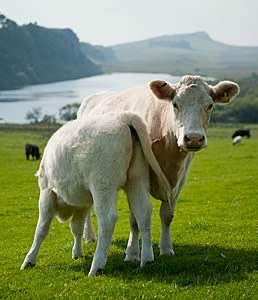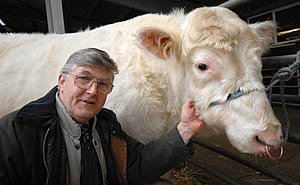 |
|||||||||
|
|||||||||||||||||||
|
|
Whitebred Shorthorn to Ranchers' Rescue Ranchers in the US who are being forced to re-evaluate the economics of their beef production systems are looking to one of the UK’s oldest breeds, the Whitebred Shorthorn, for help.
Higher oil and grain prices in the US are forcing producers to re-consider the type of cattle they are rearing and go back to basics with cattle that can process forages cheaply and efficiently. Spearheading the move is Keith Nafziger, a commercial airline pilot who raises grass-fed, heritage breeds of cattle and sheep on a small farm near Hillsboro, Oregon. “Our beef program in the US has developed the last fifty years around the concept of cheap, subsidized, government corn. So the push has been on to develop a beef animal that had a very large frame for butchering efficiency and could survive and finish quickly in a concrete feed yard,” said Mr Nafziger. “Beef production costs have been increasing exponentially due to higher oil and grain prices. Ranchers in the States are being forced to reevaluate every dollar they spend. The movement is a foot to return to the old ways. With 220 breeding females across 31 pure bred herds in the UK, the Whitebred Shorthorn has moved from the Rare Breed Survival Trust's Critical species list to its Endangered category. Traditionally, the Whitebred Shorthorn has been bred to produce bulls to cross with the Galloway cow to produce hardy Blue Grey calves. Native British breeds are becoming increasingly popular because of the quality of their meat, their ease of management and in the UK their suitability for environmental schemes.
“We’re hoping that we can persuade people that this breed has a bright future but we desperately need more breeders - 31 is too few - and the breed is worth much more than that,” said Whitebred Shorthorn Association chairman Adrian Wheelwright. “It does a wonderful job on other breeds such as the Galloway to produce the Blue Grey but we don’t just have one market to fill. The breed needs bringing out of the locker. “Sales of Blue Greys did well last autumn because of increased interest in traditional cattle but we need to widen the use of the Whitebred Shorthorn which produces a great cross with Highland, Aberdeen Angus, Welsh Black, Simmental as well as Holsteins and Ayrshires.” After a worldwide search it was decided that the Whitebred Shorthorn fitted every parameter the US breeders were searching for. Mr Nafziger said the cattle’ s moderately sized frame was very important for efficiently finishing on a forage only diet. Their white colour with a double hair coat in the winter make them temperature tolerant from the Texas summer heat of 40 degrees Celsius to the Montana winter cold that can reach -40 degrees. “This breed has only been exposed to grass and forbs not grain. The Whitebred Shorthorn is a non-selective grazer and will eat plants that other beef breeds will not. They are an early maturing, easy finishing and high-quality milk producing breed. The last trait mentioned above being desperately important to producing high quality grass fed and finished beef,” said Mr Nafziger. “We hope to land some embryos this year and to establish a purebred herd that will serve as a dual purpose animal producing high quality grass fed milk for cheese making and beef finishing. We also hope to be able to establish enough genetic lines here in the States that we have a self sustaining base. We envision eventually selling cows and bulls to grass only producers all over the United States.
|
||||||||||||||||||

|
|
||||||||||||||||||
| home | agri-services | pedigree
pen | news | dairy | beef | machinery property | organisations | site map |
|||||||||||||||||||


